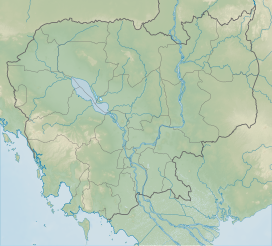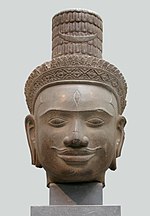
Back Phnom Bok Spanish پنوم بوک Persian Phnom Bok French Phnom Bok Italian ប្រាសាទភ្នំបូក Cambodian Phnom Bok LLD ഫ്നോം ബോക് Malayalam Phnom Bok NB Phnom Bok Vietnamese
| Phnom Bok | |
|---|---|
 Phnom Bok hill | |
| Highest point | |
| Elevation | 205 m (673 ft)[1] |
| Coordinates | 13°27′57″N 103°58′59″E / 13.46583°N 103.98306°E |
| Geography | |
| Location | Siem Reap, Cambodia |
| Climbing | |
| Easiest route | drive or hike |
| Phnom Bok Temple | |
|---|---|
Prasat Phnom Bok | |
 | |
| Religion | |
| Affiliation | Hinduism |
| Province | Siem Reap |
| Deity | Shiva, Vishnu and Brahma |
| Location | |
| Location | Angkor |
| Country | Cambodia |
| Geographic coordinates | 13°27′58″N 103°58′55″E / 13.46611°N 103.98194°E |
| Architecture | |
| Type | Bakheng style of Khmer architecture |
| Creator | King Yasovarman I (889–910 AD) |
| Completed | 9th–10th century |
| Specifications | |
| Temple(s) | Three |
| Elevation | 221 m (725 ft) |
Phnom Bok (Khmer: ភ្នំបូក) is a hill in the northeast of Eastern Baray in Cambodia, with a prasat (temple) (Khmer: ប្រាសាទភ្នំបូក) of the same name built on it. It is one of the "trilogies of mountains", each of which has a temple with similar layout. The creation of the temple is credited to the reign of Yasovarman I (889–910)[2]: 65 between 9th and 10th centuries; established after he moved his capital to Angkor and named it Yasodharapura. The two other sister temples, named after the contiguous hills, are the Phnom Bakheng and Phnom Krom.[3]: 113 [4][5]
The site of the three hills was chosen by Yashovarman I along with the Eastern Baray (where only the base of the central shrine is surviving). In the 10th century, these shrines had high religious value during the Angkorian rule.[6] The temples called as part of an "architectural triad" brought about an element of experimentation in architectural style in the Angkorian period.[7] From the astronomical references planned for three temples, out of the four noted alignments three, namely, equinox and winter and Solar Solstices could be observed from inside the western entrance of Phnom Bok hill temple, which is also known for the triple sanctuary dedicated to the Trimurti.
- ^ Google Earth
- ^ Higham, C., 2001, The Civilization of Angkor, London: Weidenfeld & Nicolson, ISBN 9781842125847
- ^ Coedès, George (1968). Walter F. Vella (ed.). The Indianized States of Southeast Asia. trans.Susan Brown Cowing. University of Hawaii Press. ISBN 978-0-8248-0368-1.
- ^ Lonely Planet Publications (Firm) (1992). Cambodia: a travel survival kit. Lonely Planet Publications. pp. 132, 172. Retrieved 22 May 2011.
- ^ "Phnom Bok". Theangkor.net. Archived from the original on 25 April 2011. Retrieved 22 May 2011.
- ^ Jacques Dumarçay; Pascal Royère; Michael Smithies (2001). Cambodian architecture: eighth to thirteenth centuries. BRILL. pp. 60–62. ISBN 978-90-04-11346-6. Retrieved 22 May 2011.
- ^ Ya Tai chuan tong yi shu lun tan yan tao hui lun wen ji, 2000.10.9–12. National Center for Traditional Arts. 2002. pp. 71–. ISBN 978-957-01-0880-4. Retrieved 22 May 2011.




